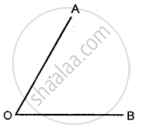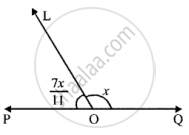Advertisements
Advertisements
Question
The adjoining figure shows two straight lines AB and CD intersecting at point P. If ∠BPC = 4x – 5° and ∠APD = 3x + 15°; find:

(i) the value of x.
(ii) ∠APD
(iii) ∠BPD
(iv) ∠BPC
Solution
(i) 4x - 5 = 3x + 15 (∵ ∠CPB = ∠APD; opposite angles)
⇒ 4x - 3x = 15 + 5
⇒ x = 20
(ii) ∠APD = 3x + 15
= (3 × 20) + 15
= 60 + 15 = 75°
(iii) ∠BPD = 180 - ∠BPC
= 180 - (4x - 5)
= 180 - 4x + 5
= 185 - (4 × 20)
= 185 - 80 = 105°
(iv) ∠BPC = 4x - 5
= (4 × 20) - 5
= 80 - 5
= 75°
APPEARS IN
RELATED QUESTIONS
In your note-book copy the following angle using ruler and a pair compass only.

Construct the 60° angle, using ruler and a pair of compass only.
Construct the 90° angle, using ruler and a pair of compass only.
Construct the 120° angle, using ruler and a pair of compass only.
Draw ∠PQR = 75° by using set- squares. On PQ mark a point M such that MQ = 3 cm. On QR mark a point N such that QN = 4 cm. Join M and N. Measure the length of MN.
In the following figure, BA is parallel to CD. Find the angles a, b and c:

Two straight lines are cut by a transversal so that the co-interior angles are supplementary. Are the straight lines parallel?
In the case given below, find the value of x so that POQ is straight line

In the case given below, find the value of x so that POQ is straight line

Draw a line AB = 9 cm. Mark a point P in AB such that AP=5 cm. Through P draw (using set-square) perpendicular PQ = 3 cm. Measure BQ.
